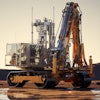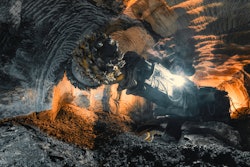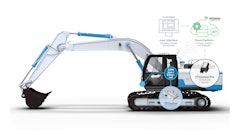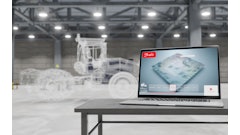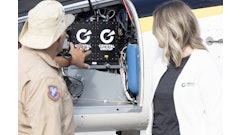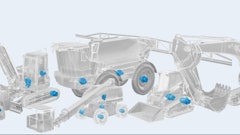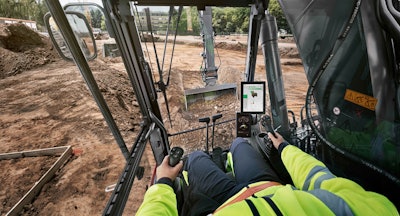
Using GPS functionality on construction equipment to automate tasks is becoming more common, and some OEMs have made these features standard on new equipment. Though many owners and operators are getting more comfortable with—and even dependent upon—technology to help them be more productive, some may still need a little help making sense of it all.
How GPS Can Help
Machine control is now widely used on excavators and dozers, but systems that support GPS can take things to another level for digging accuracy and more complicated shapes. Typically, inertial measurement unit (IMU) sensors are mounted to certain parts of a machine and can tell the operator where the bucket tooth is and therefore, how close they are to a target depth or grade. Upgrades can include satellite antennas and smart receivers, which make up GPS functionality and allow the machine to “know” where it is.
For example, on an excavator, the operator can use an in-cab interface (like a tablet) to draw the shape he or she wants to dig. Let’s say it’s a basement. Then he or she can put the bucket on the ground where one corner of the basement will be, move the bucket to a second spot and that tells the machine to “draw” a wall between the two. Depth and slope can be factored in, as well. Thanks to the sensors and satellite receivers, the machine will remember where every point is as it moves around the site.
Upgrading to 3D software like Trimble or Topcon takes GPS support one step further. These programs can import a computer-aided-design (CAD) file for an entire jobsite, such as the roads, water and sewer lines for a housing subdivision. All GPS-equipped machines will know how far to dig no matter where they are located on that site.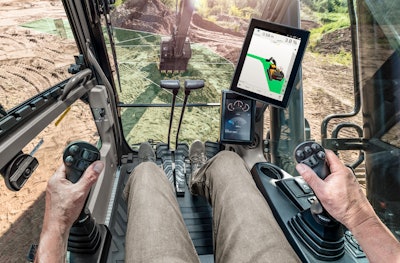 An operator uses 3D dig assistanceVolvo Construction Equipment
An operator uses 3D dig assistanceVolvo Construction Equipment
Some GPS software allows operators to create layers, as well. Suppose you’re putting in a water line that involves multiple material layers with specific requirements for each. Let’s say you want 6 inches of sand as your base, 3.5 feet of gravel, 2 feet of fill soil and then 1 foot of topsoil. Having a screen show exactly where you are will make that work much easier and faster, preventing rework and minimizing the danger of having a person in the trench measuring depths.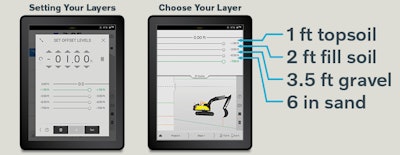 Material layering exampleVolvo Construction Equipment
Material layering exampleVolvo Construction Equipment
Another safety-boosting feature supported by sensors and electro-hydraulic technology is swing control, also known as swing fencing. An operator can create what is basically an invisible “wall” so they cannot swing into traffic, other machines or people. The machine will remember where the wall is and stop itself from breaking it. Similarly, height or depth limits can be set to avoid hitting objects or clipping utilities, for example. Object detection is beginning to find its way into the market, as well, which will do exactly what it says and alert operators when something is in the way.
Perhaps one of the most exciting GPS-related features still growing in functionality and adoption is jobsite mapping. With this, all machines on a given site can see where the others are, helping operators avoid traffic and safety concerns and improving jobsite (and fuel) efficiency. For mapping to take hold in the industry, better jobsite connectivity will be needed so data can more easily be shared between machines in real time.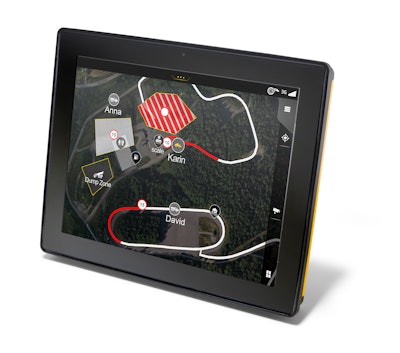 A jobsite mapVolvo Construction Equipment
A jobsite mapVolvo Construction Equipment
Automation Goes a Step Further
Automating certain tasks can improve efficiency even more. To give another excavator example, many systems will “cut grade” on the final pass. But with automation technology, the operator will control only the arm while the computer will control the boom and bucket to ensure the last pass is smooth and at the right depth.
Some articulated trucks and wheel loaders come with a speed limiter option that automatically regulates maximum speed. If you're in a region that sets speed limits on worksites, this could help reduce the potential for fines while improving safety and managing site traffic.
Many compactors and pavers also have assistive technologies that allow operators to see how many passes they’ve made, the temperature of the material, its density and other important data that can improve their productivity.
Advancements are happening quickly in the realm of automation. Some OEMs have semi-autonomous machines on the market, and some are working on fully autonomous versions. The automated features on today’s machines do a nice job setting the stage for these larger-scale developments.
Additional Interface Features
Assistive technology (not GPS-related) can also help the operator make real-time adjustments to boost efficiency. Coaching tools can identify and alert operators of trends in idling, braking, accelerating, fuel consumption, improper work modes and more. The operator can choose to adjust their behavior accordingly or ignore the alerts, so keep in mind that a machine is never more efficient than its operator.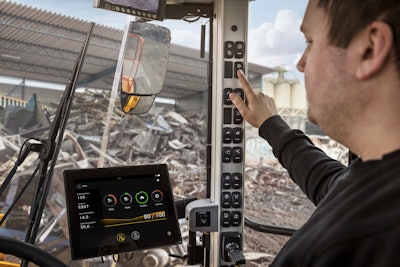 An operator responds to coachingVolvo Construction Equipment
An operator responds to coachingVolvo Construction Equipment
With the current labor shortage, some owners or fleet managers view these coaching tools as great recruiting and training tools. Less-experienced operators can learn directly from the machine and become more confident in their skills.
Features that can shorten loader cycle times include boom kickout and return-to-dig. Boom kickout makes the boom stop at a predetermined point while lifting, which is especially helpful when loading a truck at the same height for an extended period. Return-to-dig stops the boom while lowering, helping the operator return the bucket to the same position every time so it’s ready to dig into the pile again. When these functions aren’t done properly, you’ll see the machine bucking or even getting stuck, which disrupts the cycle and puts unnecessary wear on the tires and machine.
One of the most popular automated tools is on-board weighing. Not every worksite can have a scale handy, and even if they did, it could slow things down. If a machine can weigh its load on its own, operators can skip adding or dumping material and reweighing, saving lots of time and fuel. Overloading can also increase wear on a machine and lead to overweight fines.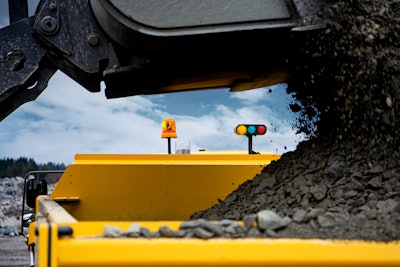 Onboard weighing is a popular feature for many operators and is recommended to OEMs.Volvo Construction Equipment
Onboard weighing is a popular feature for many operators and is recommended to OEMs.Volvo Construction Equipment
Another favorite feature is the work mode or response mode. Excavators often have work modes like fine, general and heavy, and wheel loaders may have response modes like soft, active and normal. These can adjust things like engine rpms, hydraulic lever sensitivity and fuel consumption. Some operators think working in the highest mode possible is the way to go, but that isn’t always the case and it isn’t the best use of your machine or fuel. Running 200 to 300 rpms lower can equate to a 10% reduction in fuel use on many machines, without affecting performance.
Customizing for Success
With many of the technologies mentioned here, operators can program certain buttons and levers to remember their preferred specs, making their job even easier. And if multiple operators use the same machine, they can have their own profile that remembers how each of them prefers things to work. It may take a little time to set these up, but the time saved down the road far outweighs that issue.
While some of this technology sounds quite advanced, it’s typically easy to learn and use, and operators find that they work much faster and more accurately. Less rework means better productivity, higher profits and lower total cost of ownership, so don’t let a fear of the unknown keep you away. Your competitors may leave you in the dust if you do.
Matthew McLean is product manager – GPE products for Volvo Construction Equipment, North America. Jenny Olsen is a product specialist – machine control for Volvo Construction Equipment, North America.

